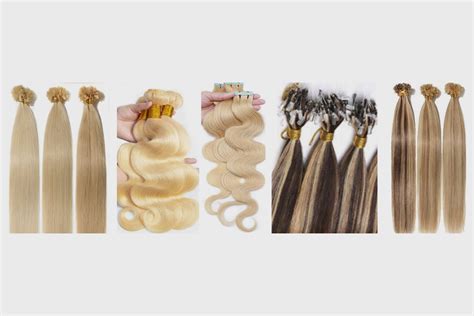Introduction

Synthetic hair extensions have revolutionized the beauty industry, offering individuals endless possibilities to enhance their natural locks. With a variety of types, colors, and textures available, synthetic hair extensions cater to every taste and preference. In this comprehensive guide, we delve into the world of synthetic hair extensions, exploring their benefits, limitations, and innovative applications.
Types of Synthetic Hair Extensions
There are five primary types of synthetic hair extensions:
-
Kanekalon: Known for its affordability and versatility, Kanekalon extensions are made from a synthetic fiber called modacrylic. They resemble human hair in texture and feel, making them a popular choice for beginners.
-
Toyokalon: Considered the most premium synthetic hair extension, Toyokalon is made from a heat-resistant fiber that can withstand styling temperatures up to 180 degrees Celsius.
-
Cyberlox: Created using a blend of synthetic and human hair, Cyberlox extensions offer the best of both worlds. They provide natural-looking volume and shine while maintaining durability.
-
Human Hair Blend: These extensions are a mix of synthetic and human hair, offering a balance of cost and quality. They are ideal for creating subtle enhancements or blending in extensions with natural hair.
-
Bio-Synthetic: A new generation of synthetic hair extensions, bio-synthetic extensions are made from plant-based materials, such as corn or soybeans. They are biodegradable, environmentally friendly, and offer a similar look and feel to human hair.
Benefits of Synthetic Hair Extensions
- Affordability: Synthetic hair extensions are significantly more affordable than human hair extensions, making them accessible to a wider range of consumers.
- Versatility: With a wide array of colors, textures, and lengths available, synthetic hair extensions offer endless styling options.
- Durability: Synthetic fibers are inherently strong and durable, making them resistant to damage from heat styling and chemical treatments.
- Low Maintenance: Unlike human hair extensions, synthetic hair extensions require minimal maintenance, making them a convenient and hassle-free solution.
- Hypoallergenic: Synthetic hair extensions are non-allergenic, making them suitable for individuals with sensitive skin or scalp conditions.
Limitations of Synthetic Hair Extensions
- Shine: Synthetic hair extensions may not have the same natural shine as human hair, especially when exposed to sunlight or flash photography.
- Texture: While some synthetic hair extensions are designed to mimic human hair texture, they may still feel less natural to the touch.
- Heat Resistance: While some synthetic hair extensions can withstand heat styling, they may not hold curls or waves as well as human hair extensions.
- Tangle: Synthetic hair extensions can be prone to tangling, especially when exposed to wind or humidity.
- Lifespan: Synthetic hair extensions typically have a shorter lifespan than human hair extensions, lasting for around 3-6 months with proper care.
Innovative Applications
The versatility of synthetic hair extensions extends beyond traditional hair enhancement. These innovative applications offer endless possibilities:
- Wig Making: Synthetic hair extensions can be used to create custom wigs for fashion, cosplay, or medical reasons.
- Cosplay and Costume Design: Synthetic hair extensions in vibrant colors and unique textures are ideal for creating realistic costumes and character transformations.
- Hair Toppers and Fillers: Synthetic hair extensions can be used to conceal hair loss or thinning areas, creating a fuller and more voluminous look.
- DIY Hair Accessories: Synthetic hair extensions can be incorporated into handmade hair accessories, such as hair clips, headbands, and hair extensions.
- Textile Applications: Synthetic hair extensions can be used to create innovative textiles, such as synthetic fur, upholstery, and decorative fabrics.
Comparing Pros and Cons
| Pros | Cons |
|---|---|
| Affordable | Less natural shine |
| Versatile | Can be prone to tangle |
| Durable | May not hold curls or waves as well as human hair extensions |
| Low maintenance | Shorter lifespan than human hair extensions |
| Hypoallergenic | Not as breathable as human hair |
FAQs
-
How long do synthetic hair extensions last?
Typically 3-6 months with proper care. -
Can synthetic hair extensions be dyed?
No, synthetic hair extensions cannot be dyed. -
Can synthetic hair extensions be straightened or curled?
Yes, but only with heat tools specifically designed for synthetic hair. -
How often should synthetic hair extensions be washed?
Every 6-8 wears or as needed. -
Can synthetic hair extensions damage my natural hair?
No, when applied and handled properly. -
Are synthetic hair extensions difficult to remove?
They can be removed by a professional or at home using the appropriate removal solution. -
How can I prevent tangles in synthetic hair extensions?
Brush extensions gently with a wide-tooth comb, use detangling spray, and avoid sleeping with wet hair. -
What is the best way to store synthetic hair extensions?
Store in a cool, dry place in a hairnet or bag.
Conclusion
Synthetic hair extensions have emerged as a versatile and affordable solution for enhancing natural hair. With their wide range of types, colors, and textures, they offer endless possibilities for transforming one’s appearance. While they may have certain limitations compared to human hair extensions, their low cost, low maintenance, and innovative applications make them a valuable addition to any beauty kit.
